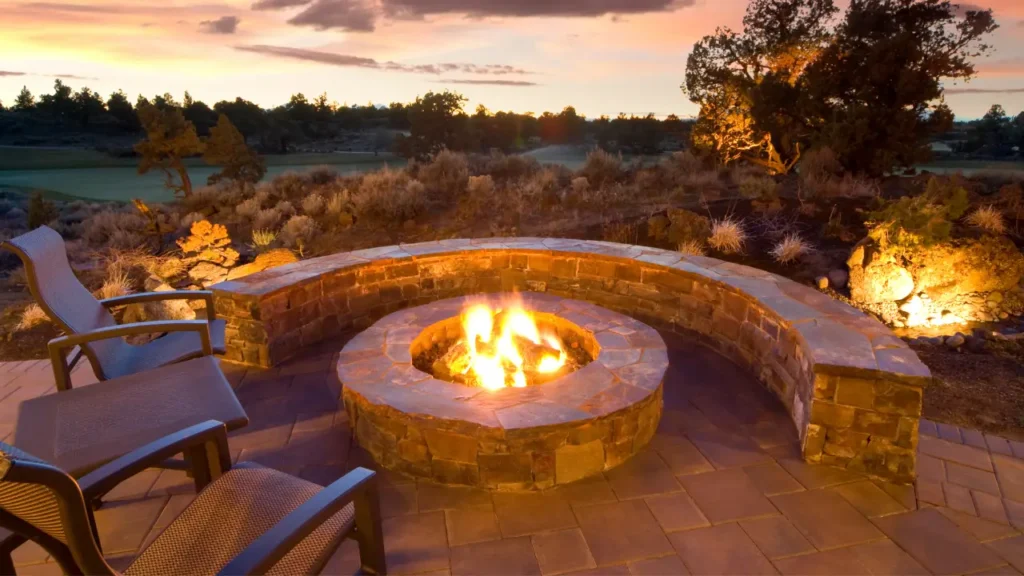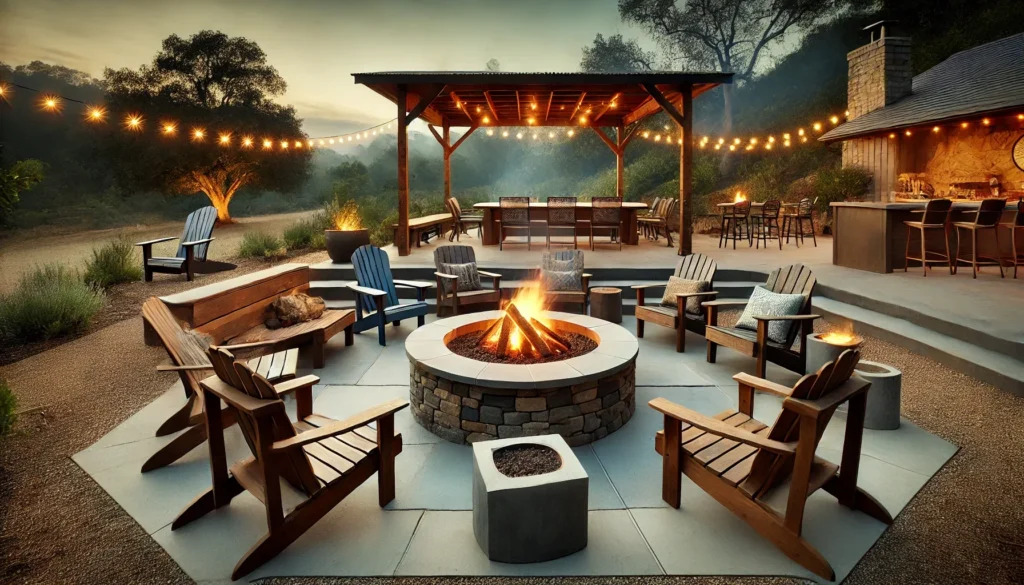Ever found yourself constantly dodging smoke clouds while trying to enjoy a cozy backyard fire? Traditional fire pits are notorious for billowing smoke, stinging eyes, and leaving you smelling like a campfire long after the embers fade. But what if you could experience the mesmerizing glow and comforting warmth of a real wood fire without the overwhelming smoke?
Enter the smokeless fire pit – a revolutionary outdoor heating solution that promises a dramatically cleaner, more enjoyable fire experience. If you’ve ever wondered “how does a smokeless fire pit work?” and what makes it so different, you’re in the right place.
This article breaks down the ingenious science behind smoke reduction, revealing the key technologies (like secondary combustion and clever airflow design) that transform your fire pit gatherings into truly comfortable, smoke-free events.
How Does a Smokeless Fire Pit Work?
To understand how a smokeless fire pit works, we first need to break down the science of fire itself. Combustion—the process of burning—is essentially a chemical reaction between fuel (like wood), heat, and oxygen. For a fire to burn cleanly, it needs all three in the right balance.
If oxygen is limited or the fuel isn’t hot enough, the burn will be incomplete, producing smoke as a byproduct. Smoke is made up of tiny particles (mostly carbon and other organic matter) that didn’t fully burn.
Think of it like cooking: if you undercook a piece of meat, you don’t get the full flavor or texture you want. The same goes for fire—if you don’t give it enough heat and oxygen, it won’t burn completely.
That incomplete burn is exactly what causes smoke to billow out of traditional fire pits.
How Secondary Combustion Eliminates Smoke
The “smokeless” magic happens thanks to something called secondary combustion. A smokeless fire pit pulls in air from the base, heats it up between the double walls, and releases it through small holes near the top of the inner wall. This superheated oxygen mixes with the smoke rising from the burning wood and ignites it a second time.
That second burn consumes much of the smoke particles before they can escape into the air.
This process also makes the fire hotter and more efficient. With more complete combustion, you get more heat from the same amount of fuel—and less waste in the form of smoke. In fact, many users find they need less wood overall compared to traditional pits, which saves money and reduces the environmental impact.
Key Components of a Smokeless Fire Pit
Airflow Systems
The engineered airflow in a smokeless fire pit is its most crucial feature. It’s not random—it’s carefully designed to ensure oxygen enters from below, circulates through heated channels, and exits at the perfect spot to ignite leftover smoke.
This airflow not only burns the fuel more completely but also keeps the fire more consistent, avoiding those moments where it suddenly dies down.
Double-Wall Construction
The hallmark of most smokeless fire pits is their double-wall construction. This design creates an insulated channel for air to pass through and heat up before entering the combustion zone.
The inner wall contains the fire itself, while the outer wall remains cooler to the touch—an added safety benefit for family settings.
Ventilation Holes and Heat Flow
Ventilation holes are placed both at the bottom and near the top of the fire pit’s inner wall. The bottom holes feed oxygen directly to the fire from beneath, aiding primary combustion.
The top holes allow the preheated air to ignite smoke particles during secondary combustion. This clever arrangement is what keeps the smoke to a minimum.
Step-by-Step Process of How It Works
- Air Intake at the Base
- Cool air enters through holes at the bottom, supplying oxygen to the fuel. This oxygen feeds the primary fire, ensuring strong flames.
- Heating and Rising of Air
- As the air travels upward between the two walls, it heats up dramatically.
- Secondary Burn of Smoke Particles
- The heated air is expelled through the top vents, where it meets the smoke and burns it off before release.
Advantages of Using a Smokeless Fire Pit
1. Cleaner Air and Less Pollution
One of the most significant advantages of a smokeless fire pit is its ability to produce a cleaner burn, which means fewer airborne pollutants. Traditional fire pits can release large amounts of particulate matter—tiny bits of ash, soot, and other byproducts of incomplete combustion—that contribute to poor air quality.
For anyone with allergies, asthma, or respiratory sensitivity, this can be a major issue. With a smokeless fire pit, the secondary combustion process burns these particles before they escape into the atmosphere, drastically cutting down on smoke output.
Not only does this mean cleaner air for you and your guests, but it also reduces the environmental impact. Lower smoke emissions mean fewer pollutants contributing to smog or poor local air quality. Plus, because these fire pits burn fuel more efficiently, you end up using less wood or pellets over time, which further minimizes environmental strain.
The air quality benefits are especially noticeable in smaller backyard spaces or campgrounds where multiple fires might otherwise create a smoky haze. Imagine enjoying a fire without having to worry about irritating your lungs—or your neighbor’s. That’s a win for everyone involved.
2. Improved Heat Output
Another huge perk is the increased heat efficiency. Because smokeless fire pits encourage more complete combustion, they extract more energy from every piece of fuel. This means you get hotter flames and more radiant heat compared to a traditional pit using the same amount of wood.
Think of it like upgrading from a campfire to a miniature furnace—you’re getting more bang for your buck. This is especially valuable in cooler weather, where that extra heat can make the difference between cutting the night short or staying outside comfortably for hours.
Also, the even heat distribution is worth mentioning. Traditional fires can have “hot spots” and cooler edges, but smokeless fire pits often radiate heat more uniformly, making them better for gatherings where everyone is sitting around the circle.
3. Better for Social Gatherings
Let’s be honest—half the fun of a fire pit is hanging out with friends and family. But nothing kills the mood faster than having to constantly shift your seat to dodge smoke clouds. With a smokeless fire pit, that problem is virtually eliminated.
You can sit anywhere around the pit without worrying about the wind blowing smoke in your face.
Plus, because you’re not choking on smoke or smelling like a bonfire for the next two days, it’s easier to relax and enjoy the moment. People can linger longer, conversations flow better, and you can focus on the warmth, light, and ambiance rather than irritation.
It’s not just a comfort thing either—it’s also a safety plus.
Clearer air means better visibility, which is especially helpful if kids or pets are running around.
How to Use a Smokeless Fire Pit Safely
1. Choosing the Right Location
A smokeless fire pit may produce less smoke, but it still gets extremely hot and should be placed on a heat-resistant surface, away from overhanging branches, fences, or flammable materials.
Flat, stable ground is ideal, and keeping at least a 10-foot clearance around the pit is recommended.
2. Proper Fuel Loading
Start with small, dry kindling at the base, then gradually add larger pieces of wood. Overloading the pit right away can block airflow, leading to incomplete combustion and more smoke.
3. Monitoring and Extinguishing the Fire
Even though they’re more efficient, smokeless fire pits still require supervision. Never leave one unattended, especially if children or pets are nearby.
When you’re ready to put the fire out, let it burn down naturally or carefully spread out the embers and douse them with water, stirring until all heat is gone.
You May Also Like To Read:
Affiliate Disclosure: Fireplaceadviser.com is a participant in the Amazon Services LLC Associates Program. We may earn a commission when you click on certain links on this site and purchase.

Hello!! I am Jamal Khan. I often fix my home electric heaters and gas stove problems and research the common issues in the heating units to improve my knowledge and expertise. The aim of establishing fireplaceadviser.com is to share my expertise and knowledge with my audience.




















